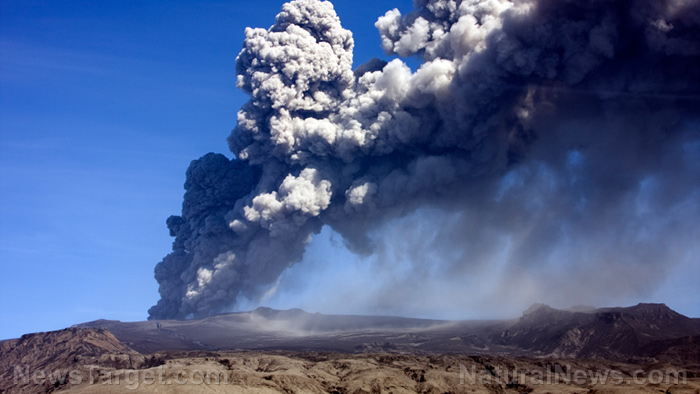Transport of tropical ocean heat causes over-estimation of global average temperatures
10/27/2021 / By Zoey Sky

Book author and teacher Jim Steele explained in a video that the transport of tropical ocean heat raises the Arctic’s temperature and potentially causes over-estimation of global average temperature. Steele also explained how extensive transport of tropical ocean heat uniquely warms the Arctic.
In 1983, Jim Steele worked with Dr. James Kelley, the dean of the College of Science and Engineering at San Francisco State University, to resurrect and grow the Sierra Nevada Field Campus. The two helped turn the rustic Sierra Nevada Field Campus into one of California’s leading environmental education centers.
Steele helped build the Sierra Nevada’s environmental education program and taught several classes, namely World of Plants, Nature Study, Natural Sciences for Teachers, Bird Banding and Bird Identification by Song. He later taught at the cell and molecular biology labs for the introductory biology class for majors at San Francisco State University.
Steele also wrote the book “Landscapes & Cycles: An Environmentalist’s Journey to Climate Skepticism.”
Steele: Statistics are often abused
The Arctic has warmed dramatically and some researchers point to polar amplification of greenhouse warming. However, Steele explained that this simplistic explanation doesn’t clarify why most of Antarctica has never warmed at the Southern pole.
This also shows how alleged experts abuse statistics to average extreme warming temperatures in the Arctic with temperatures elsewhere, like the cooling in North America. Averaging two temperatures caused by vastly different dynamics isn’t helpful when it comes to understanding climate change.

Steele also gave an overview of how the world’s ocean temperatures vary. The oceans are warmest in the tropics. And because of the sun’s intense heating of the surface, temperatures are averaging 20 C (68 F).
Ocean temperatures decrease towards the higher latitudes as the Earth’s curve and the axis tilt decrease solar heating. Between 50 and 60 degrees south latitude, temperatures are much lower, with an average of five to zero C. Because of the Antarctic circumpolar current, the warmer subtropical waters can’t intrude further south. This prevents any warming of Antarctica.
In contrast, warm subtropical waters intrude deep into the Arctic.
Steele noted that some researchers and laypeople have much to learn about Arctic warming and how ocean circulation affects the Arctic. The northern hemisphere’s circular pattern of ocean circulation creates subtropical gyres. A similar pattern also occurs in the southern hemisphere.
Tropical waters are warmest because of solar heating
The tropical waters are warmest because of intense solar heating. This heating also generates the trade winds blowing water from the east to the west. As it reaches the ocean’s western boundary, heated waters are guided towards the poles through the Gulf stream in the Atlantic and the Kuroshio current in the Pacific.
After reaching the mid-latitudes, the westerly winds guide the warm waters back towards the east. At the continents’ west coast, the cooler waters are pumped back towards the equator to complete the subtropical gyre’s circulation.
Understanding this process is crucial because the currents moving back towards the equator also create the four upwelling regions that support humanity’s richest fisheries. Data also shows that in the southern hemisphere, the gyre’s warm tropical waters don’t penetrate past the Antarctic Circumpolar Current. This keeps Antarctica cooler than average.
On the other hand, there is a slight leakage of warm water from the Pacific through the Bering Strait and into the Arctic. The large volume of warm water transported via the Gulf stream into the north Atlantic enters the Arctic, which melts sea ice and warms the region. (Related: Biden declares ‘code red’ on climate change amid Arctic Sea ice EXPANSION… It’s all a hoax.)
Researchers have placed moorings along the major pathways, like the Fram straight and elsewhere, to monitor the inflows and estimate changes in temperature and volume of inflowing Atlantic water.
However, Steele noted that it can be very difficult to measure exactly the amount of redistributed heat. This is partly due to inflowing waters following very complex pathways as they ventilate heat and mix with cooler Arctic ocean waters.
Additionally, an increase in the volume of inflows raises water temperatures even without changes in the inflow’s temperature. At the same time, less inflow volume can warm the Arctic if the source waters of the inflows are warmer.
Estimating temperature changes in the source of the inflowing waters is another complicated task since temperatures of the North Atlantic waters vary due to factors like the natural Atlantic Multi-decadal oscillation.
In a 2018 peer-reviewed study, Alfredo Ruiz-Barradas said that between the 1980s and the 1990s, the North Atlantic warmed. However, it has been cooling since then.
Sources include:
Tagged Under: Arctic Sea, climate change, climate science, discoveries, environment, global average temperature, research, tropical ocean heat, truth





















